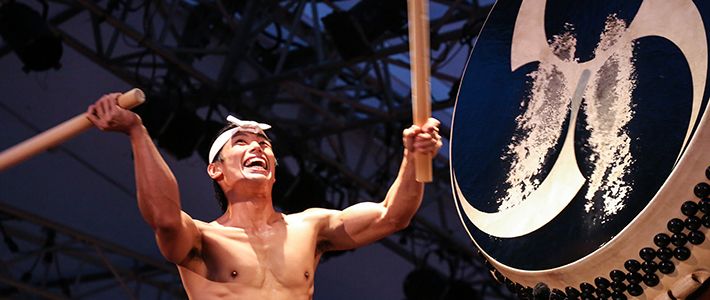
“Taiko” Drums
Society Culture- English
- 日本語
- 简体字
- 繁體字
- Français
- Español
- العربية
- Русский
Rhythm and Movement
The appeal of Japan’s traditional taiko drumming lies in its vigorous and powerful sound, which stirs players and listeners alike, physically and spiritually. The instrument plays a central role in many types of traditional music and performance, and drumming is a popular pastime for many in Japan and abroad.
Part of the dynamism of the taiko is the way drummers involve their whole bodies to achieve a profound level of expression. This aspect of physical performance—almost like dancing, as powerful rhythms combine with dynamic movements—is one factor that has brought the instrument international attention. Performances by large troupes wielding sticks in perfect time as they drum complex and powerful rhythms are particularly spectacular.
 A taiko troupe performs during a summer festival.
A taiko troupe performs during a summer festival.
The instruments originally came to Japan from continental Asia. The oldest drums in the country have been discovered at sites dating back to the Jōmon period (ca. 10,000 BC–300 BC).
From ancient times the taiko was used in Japan for communicating with allies, frightening pests away from crops, and inspiring morale in battling soldiers. It also played an important role in festivals, rainmaking rituals, and the lively dancing of the bon odori.
 A little drummer girl helps out at a festival.
A little drummer girl helps out at a festival.
Taiko drumming later became an element in kabuki and other performing arts, and was increasingly heard in theaters. Since the early twentieth century, kumi-daiko ensembles playing a range of different kinds of drums have helped bring the taiko into the mainstream.
While there are various kinds of taiko, the nagadō-daiko (long-bodied drum) is considered to be the standard. This is typically made by hollowing out a beautifully grained cut of hard zelkova wood into a cylinder, stretching cowhide over the top, and fixing it in place with metal pins. Other notable traditional Japanese drums include the high-pitched shime-daiko widely used as accompaniment in nō theater and nagauta music, the ōdaikō bass drum, and the okedō-daiko, which is often carried during performances. The drumhead, which determines the tone of each taiko, is affected by such factors as thickness and how it has been processed.
Professional Performers
 Kodō member Kojima Chieko. (© Karen Steains)
Kodō member Kojima Chieko. (© Karen Steains)
 Kodō member Nakagome Kenta. (© Maiko Miyagawa)
Kodō member Nakagome Kenta. (© Maiko Miyagawa)
There are taiko ensembles all over the country representing schools, companies, and local areas. There are also many professional groups that have contributed to the instrument’s increased recognition worldwide, including acclaimed pioneers Ondekoza and Kodō. After forming in 1971, Kodō was active in Niigata Prefecture for around a decade before making its international debut at the Berlin Festival in 1981. It has since performed more than 5,500 times in 47 countries. Potential members spend two years of intensive training while living together in a converted former school on Niigata’s Sado Island. Those who make it through the rigorous selection process that follows face a further year of hands-on instruction before they are officially accepted. The group currently has 35 full members.
Along with their drumming skills, the Kodō players have become known for their superb physiques, honed by hours of strenuous training. Several books of photographs have been published showcasing the troupe’s formidable combination of power and technique.
Photo credits:
Summer festival: Matteo Kutufa
Little drummer girl: David A. LaSpina
(Banner photo: Kodō member Nakagome Kenta. © Maiko Miyagawa.)